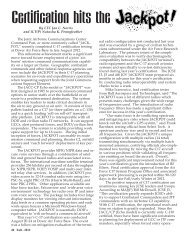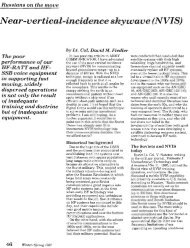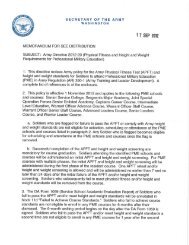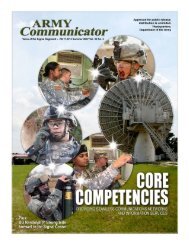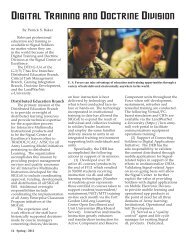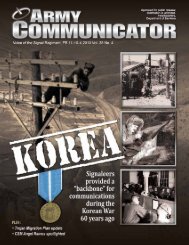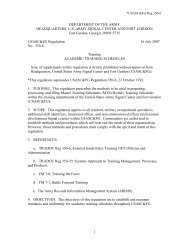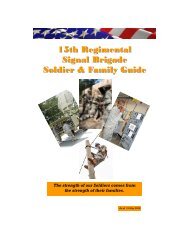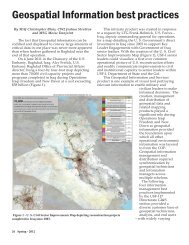AC Summer 08 WIN-T Online - United States Army Signal Center of ...
AC Summer 08 WIN-T Online - United States Army Signal Center of ...
AC Summer 08 WIN-T Online - United States Army Signal Center of ...
You also want an ePaper? Increase the reach of your titles
YUMPU automatically turns print PDFs into web optimized ePapers that Google loves.
Satellite communications for<br />
company level warfighter<br />
By Richard S.<br />
Wexler and<br />
Syed R. Ali<br />
One <strong>of</strong> the<br />
lessons learned<br />
from Iraq and<br />
Afghanistan<br />
was the need for<br />
a more robust<br />
beyond line-<strong>of</strong>sightcommunication<br />
capability<br />
between the<br />
lower <strong>Army</strong><br />
echelon land<br />
warriors, squad<br />
leaders, platoon<br />
leaders, companycommanders<br />
and the<br />
battalion<br />
commanders.<br />
These lower echelon units currently<br />
rely on radios that are propagation<br />
range constrained to the line-<strong>of</strong>-sight<br />
distance between the radios.<br />
The tactical communications<br />
radios that currently service the<br />
lower echelon <strong>Army</strong> units are<br />
dominated by two LOS Combat<br />
Network Radios that include the<br />
Enhanced Position Location Reporting<br />
System and the Single Channel<br />
Ground and Airborne Radio System.<br />
The Warfighter Information Network-Tactical<br />
Increment 2 program<br />
will develop the Soldier Network<br />
Extension On-the-Move Satellite<br />
Communications, which will augment<br />
and enhance the communications<br />
limitations <strong>of</strong> the current LOS<br />
CNRs.<br />
The BLOS communications<br />
capability <strong>of</strong> the SNE combined with<br />
its ability to communicate on-themove<br />
will help to close the communication<br />
gap existing between the<br />
various tactical legacy radio networks.<br />
This shortfall was identified<br />
by a <strong>United</strong> <strong>States</strong> <strong>Army</strong> Training<br />
and Doctrine Command study, and<br />
Figure 1. Operational view with NCW SATCOM Net to extend BN/CO-level<br />
SINCGARS and EPLRS Combat Net Radio Traffic.<br />
the need for a low cost Single<br />
Integrated Transport System was<br />
suggested. The basic requirements<br />
for providing this lower echelon<br />
communications solution include:<br />
� Interface compatibility<br />
requirements with future<br />
networking systems;<br />
� Potential for interoperability<br />
with higher echelons;<br />
� Baseband compatibility<br />
requirements with existing<br />
digitized lower echelon units;<br />
� Information Assurance/<br />
Encryption Requirements;<br />
� At-the-Halt/On-the-Move<br />
Capabilities.<br />
These requirements formed<br />
that basis <strong>of</strong> the <strong>WIN</strong>-T SNE.<br />
The network healing process is<br />
synonymous with a bridging capability<br />
whereas network thickening<br />
<strong>of</strong>fers enhanced bandwidth capability<br />
between nodes. The SNE will<br />
provide both network thickening<br />
and healing for the CNR nets that<br />
support communications between<br />
the company commanders and the<br />
battalion’s command<br />
post as<br />
depicted in Figure<br />
1. The majority <strong>of</strong><br />
the <strong>Army</strong><br />
Warfighter’s<br />
communications<br />
traffic served by<br />
the SNE network<br />
includes command<br />
and control<br />
messages and<br />
voice exchanges,<br />
as well as situational<br />
awareness<br />
traffic. The SNE<br />
would serve as an<br />
access port for<br />
extending the<br />
range <strong>of</strong> the legacy<br />
CNRs to both heal<br />
and thicken these<br />
range-limited networks.<br />
Basic requirements<br />
Some high level SNE requirements<br />
are provided below:<br />
� Operate over both commercial<br />
and Department <strong>of</strong> Defense<br />
satellites at Ku and Ka-band,<br />
respectively;<br />
� OTM and ATH 64 to 128<br />
Kbps user data rate capability<br />
(clear sky conditions – reduced<br />
throughput under rain conditions<br />
or severe satellite transponder<br />
loading);<br />
� Support IPv4/6 routed<br />
traffic;<br />
� Transmission will be based<br />
on Demand-Assigned Multi-<br />
Frequency Time Division<br />
Multiple Access <strong>WIN</strong>-T<br />
Network Centric Waveform for<br />
SATCOM application;<br />
� Hub-Assist (Hub-Spoke)<br />
and peer-to-peer connectivity;<br />
� Will support anticipated<br />
force structure subnet scheme<br />
with likely 36 members per<br />
<strong>Army</strong> Communicator 25



